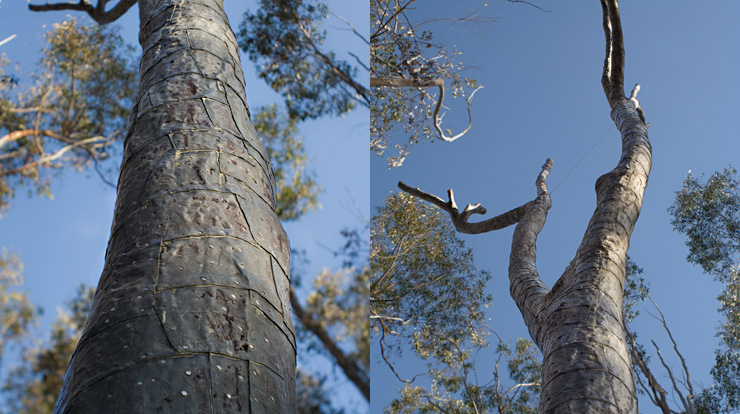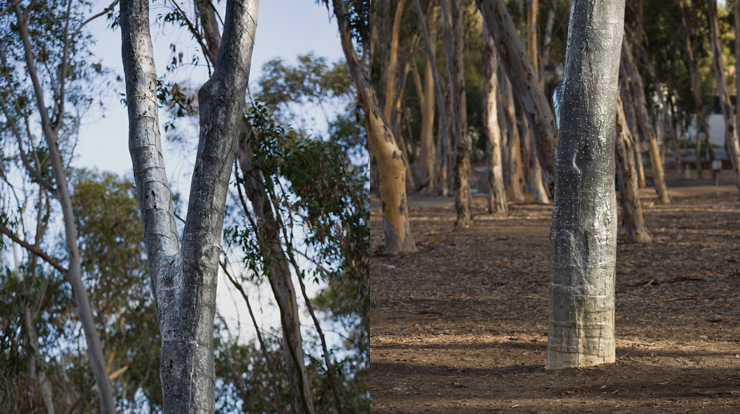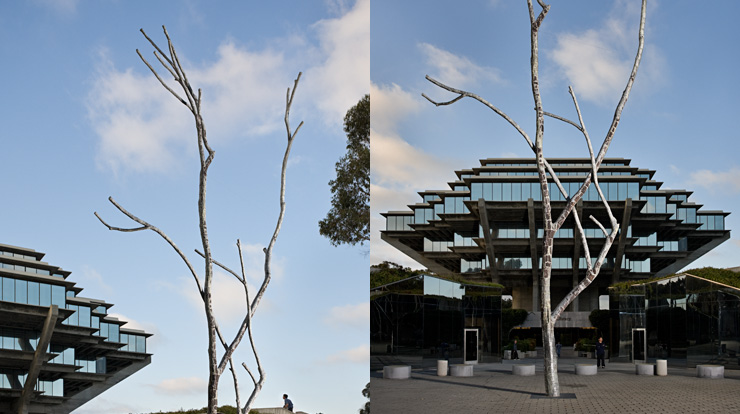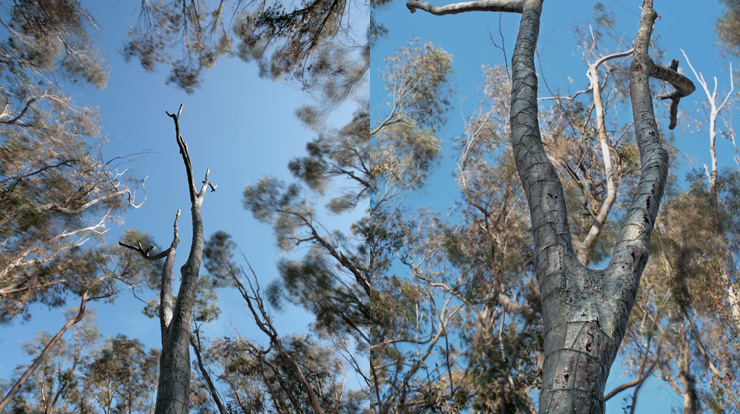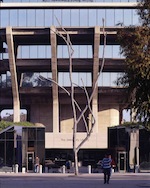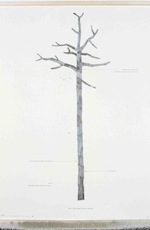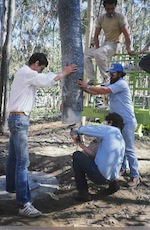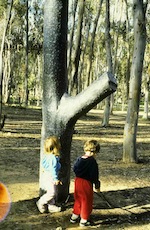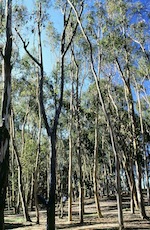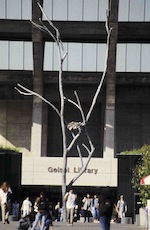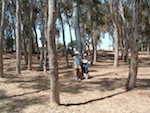Terry Allen
Trees (1986)
Location: Eucalyptus grove between Geisel Library and the Faculty Club
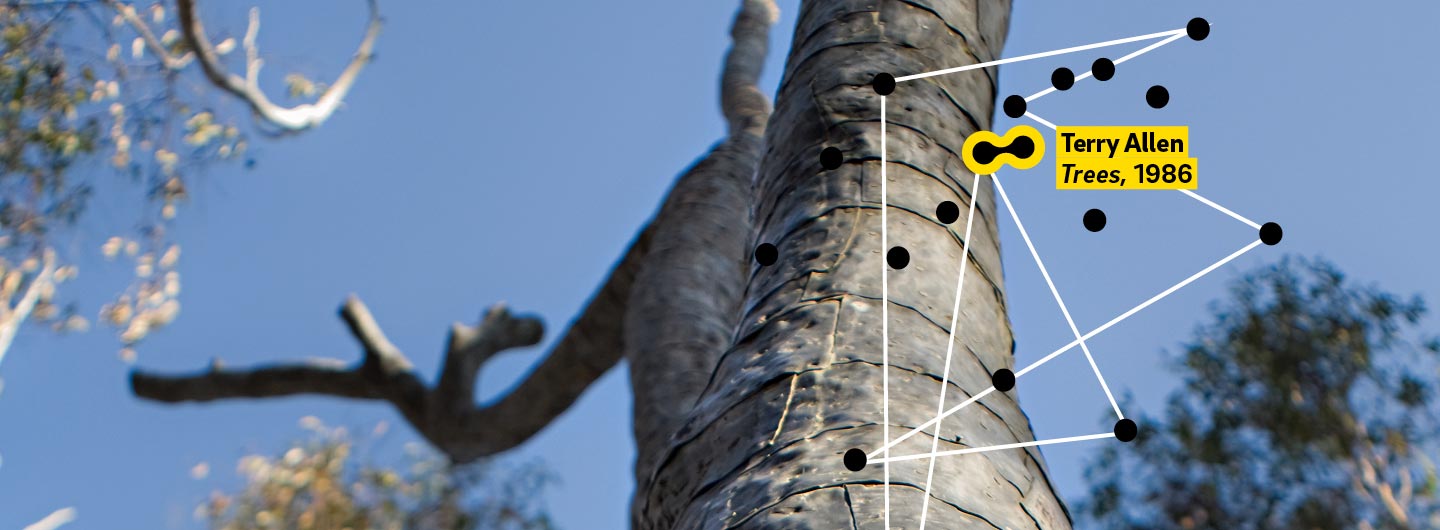
Audio Tour
About the Artist
Terry Allen is a multidisciplinary artist in the truest sense of the term. In addition to his indoor installation and sculptural work (which is emphatically mixed-media) and his paintings, writings and drawings, Allen is also a songwriter, composer, pianist, and the lead vocalist with his own Panhandle Mystery Band. Allen is well known for his installation and performance projects. One such piece, Youth in Asia, reflected on the experience of the Vietnam War by exploring American value systems through a variety of means ranging from mass cultural heroes to fairy tale protagonists like Snow White and the Seven Dwarfs, to the ethos of roadhouses in the American Southwest.
Since completing Trees, Allen has done numerous public works, among them: Corporate Head at Citi-Corps Plaza in Los Angeles; a large bronze leaf, Belief, for the Vontz Center for Molecular Research in Cincinnati, OH; a giant bronze wishbone, Wish, for DFW airport; Scioto Lounge - three humanized bronze deer on the banks of the Scioto River in Columbus, OH; and, most recently, Road Angel - a bronze 1953 Chevy with sound for Contemporary Austin/Laguna Gloria Museum in Austin, TX. Allen has released 13 albums of original music including the recently acclaimed Bottom of the World, and a new suite of prints with the same title by Landfall Press. His classic albums, Juarez and Lubbock (on everything), have been re-issued. He was the first recipient of the Townes Van Zandt Songwriting Award and is 2017 recipient of the Stephen Bruton Award for songwriting at the Lone Star Music Festival, Ft. Worth, TX. Allen lives in Santa Fe, NM with his wife, actress and writer, Jo Harvey Allen.
About the Sculpture
Allen's diverse talents and experiences are highlighted in his first outdoor project, Trees, for the Stuart Collection. He remarks upon the continual loss of natural environment at UCSD by salvaging three eucalyptus trees from a grove razed to make way for new campus buildings. Two of these trees, preserved and encased in skins of lead, stand like ghosts within a eucalyptus grove between the Geisel Library and the Faculty Club. Although they ostensibly represent displacement or loss, these trees offer a kind of compensation: one emits a series of recorded songs and the other a lively sequence of poems and stories created and arranged specifically for this project.
For the music tree, William T. Wiley, known for his paintings filled with literary puns and eccentric maps, sings Ghost Riders in the Sky, accompanying himself on a homemade instrument; West Texas singer Joe Ely sings Mona Lisa Squeeze My Guitar, while the Maines Brothers work pedal steel guitars, a Thai band plays, and filmmaker/musician David Byrne sings a song he composed especially for this project. For the literary tree, Bale Allen delivers his poem about scabs, the poet Philip Levine recites, plus there are Navajo chants, translations of Aztec poems, duck calls, and many other sound works. Trees is a continuous project and Allen and others are at work on future contributions.
One could walk through the grove several times before noticing Allen's two unobtrusive trees. Not only do these trees reinvest a natural site with a literal sense of magic but they implicitly make connections between nature and death and the life of the spirit. It is not surprising that students have dubbed this area the "Enchanted Forest."
At the entrance to the Geisel library the third tree of Allen's installation remains silent - perhaps another form of the tree of knowledge, perhaps a reminder that trees must be cut down to print books, perhaps a dance form, or perhaps noting that one can acquire knowledge both through observation of nature and through research.
Essay
Terry Allen, Trees, 1986
Terry Allen grew up in Lubbock, Texas, to become a multidisciplinary artist in the truest sense of the term. He paints. He draws. He sculpts and makes installations. He plays the piano, and occasionally other instruments. He composes music and writes lyrics. He sings as the lead vocalist with his own Panhandle Mystery Band. He has explored American value systems through a variety of means, ranging from mass-culture heroes, to fairy tale protagonists, to the ethos of roadhouses in the American Southwest. He is a dramatic storyteller and pithy aphorist in all these mediums.
When he first visited in April 1983, Terry kept insisting he wasn’t interested in public sculpture and didn’t feel comfortable in a university setting. “Outdoor art is for the birds, Mary. When I go outside I don’t want to look at art, I want to look at nature.” With some cajoling he returned to the campus late 1983, and just before leaving on a trip to Thailand he sent a long letter outlining several ideas: a large hollow metal heart with interior speakers; a partly buried car, again with speakers, to be used as a getaway place; and trees placed in a grove, also with concealed speakers that would play music and poetry. The trees seemed perfect.
There would eventually be three trees, two of which had speakers and “talked.” The third was to be silent. Terry was using sheet lead extensively in his work and decided that the trees would be covered with it, a kind of protective skin that would be similar in color to the subtle and faintly iridescent dove-gray bark of the live eucalyptus throughout the campus. We developed the proposal and a budget, which were approved by the Stuart Collection Advisory Board. The university in turn approved sites next to the library and in the adjacent eucalyptus grove on the condition that the sound would not be too loud and that the trees could be relocated if necessary, in the event of new construction.
As it happened, the university was preparing to erect several buildings at the time, and had to clear a eucalyptus grove. Mathieu Gregoire went out with a local crane company to select and carefully dismantle three trees, each around fifty feet high. On several return trips to campus, Terry decided that the two sound trees—one music, the other poetry—should be “planted” in the large grove south of the library, in places where real eucalyptus had once stood. Here, he felt, the work would summon thoughts both of displacement and loss, and of new life. Wanting to associate the silent tree with the library, he found a site for it near the entrance. The university librarian approved heartily but pleaded, “Couldn’t our tree say something too?” to which Terry replied that perhaps it could say “Ssshhh” to people entering the building. The library tree remained silent.
We worked with a structural engineer and a wood preservation company to find ways that these smooth, spindly, elegant trees could be made to stand firm and to “speak” while retaining their structural integrity over time.
The engineering was tested and the contract was signed, after a copyright agreement for the audio material had been approved by all parties. Speakers were designed to fit within the trees, which were dismantled for pressure treatment to preserve the wood, and then reassembled with metal fittings fabricated at the Scripps Institution of Oceanography Nimitz Marine Facility in Point Loma. Terry and a crew of graduate students went to work nailing squares of sheet lead, while twelve-foot-deep footings were cored. The first tree, which recites poetry and stories, was craned in and installed in January 1986. A week later the second tree, which “sings,” magically appeared.
Although these trees can be thought of as representing displacement or loss, they are very much alive: one emits a series of recorded songs and the other a lively sequence of poems and stories. All of the sound works were created and arranged specifically for this project. Terry solicited material from friends, relatives, and artists he admired, and the result is a vast range of music, stories, and poems. For the music tree, William T. Wiley sings “Ghost Riders in the Sky”; West Texas singer Joe Ely sings “Mona Lisa Won’t You Squeeze My Guitar”; the Maines Brothers work pedal-steel guitars; a Thai band plays an eerie and beautiful composition; and the musician David Byrne sings a piece he composed especially for the project. For the literary tree, Bale Allen delivers his poem about scabs; the poet Philip Levine recites; plus there are Navajo chants, translations of Aztec poems, duck calls, sounds of jet engines passing overhead, and many other contributions. This is a truly
participatory and collaborative project. Over the years songs and stories have been added to the trees, and Terry and others continue to work on future selections.
There are periods of silence between the songs and poems—pauses of up to five minutes on the music tree and longer on the poetry tree. As a result, people just passing by can be truly surprised when a tree starts to talk, or, if they are especially observant, equally surprised when they come upon a silent tree covered in lead. The trees meet the ground just like the live trees around them and the lead both absorbs and reflects the light and the surrounding color. A person could walk right by one of Terry’s trees without noticing it among the live trees in the grove, or be right next to it before being startled by its subtle difference. The mysterious lead tree skin beckons: it is soft—and often warm—to the touch. Or one might hear the sounds before realizing their source.
A participatory aspect of Terry’s trees is that students and others are welcome to scratch their initials into the lead bark, incising a shiny sliver mark in the surface of the lead—that is, until the scratch oxidizes and returns to its patina. Then others can make their own marks over existing initials, forming layers of “history,” seen and unseen, none lasting forever.
In 1988, plans for expanding the library became real. Many considered the original 1972 William Pereira building the centerpiece and icon for the campus, so the expansion and all matters related to it were sensitive subjects. At the same time, the removal of eucalyptus groves for nearby building construction had already been controversial; support for trees was increasing, but not for dead ones. We were entering delicate territory. The silent tree near the library was moved into storage during the expansion, and in 1992 Terry returned to determine the site. The new library entrance was in mirrored glass and concrete, and Terry proposed that the tree be “replanted” right in the middle of this “denatured” site, rather than being disguised somewhere else.
Given the proposed relocation, Mary tried to tell critics how inspiring the tree could be in this new site. The library behind it could invoke different thoughts: a tree of knowledge, or the presence of nature in relation to geometric form, or a sense of silence. The extended branches could be seen to invoke dance, and indeed Terry’s placement had the limbs reversed in relation to the sweep of all the nearby trees, which leaned east because of the prevailing western winds. The librarian was persuaded, but others declared the project an “ugly dead tree.” Mary suggested that ugliness, like beauty, is in the eye of the beholder, and that although some people might find the tree ugly, others certainly would not: “I acknowledged that the tree was indeed dead, but said that there are many ways to describe things, and that perhaps a university’s job was to expand those definitions. Ask people to your house for roast chicken or Thanksgiving turkey, for example, and you’ll get an entirely different response than if you invite them for dead bird.” The dean of arts and humanities, in good humor, threw up his hands and said that he could think of no reasonable objection and felt that they could no longer oppose the idea. The tree was reinstalled in June 1993. A thick lead square was inlaid at the base of the silent tree to serve as a flush plinth, integrating the cement ground plane with the tree and serving as the label. Along with the title, Terry embossed the names of everyone who contributed to or worked on the trees into the lead of both tree and plinth.
There have occasionally been creative interventions. A large nest has appeared, made of eucalyptus branches with the leaves painted silver, with three golden eggs placed high in the silent tree; and the trees in the grove have “sprouted” baby metal trees.
In 1995, when the construction of Library Walk took place, the area around the silent tree was torn up for some time. When this major campus artery was complete, however, it proved the perfect site: from afar the gray tree is a delicate tracer against the huge form of the library. The eucalyptus groves are not natural; they are in fact planted on a grid, with trees that are not native to the Americas. Trees brings to this unnatural site a literal sense of magic. In their speaking and music, and in their silence, they implicitly make connections between nature, death, and the life of the spirit.
Interview with the Artist
Interview withTerry Allen and Joan Simon
Terry Allen: I wasn’t interested in “public art.” I thought of it mainly as large heavy metal objects stuck out in front of corporations and institutions to show how rich they were. And sculpture parks seemed like graveyards full of tombstones of this stuff that hadn’t made the corporate or institutional cut. So it was ironic and somewhat unsettling when Mary invited me to make a proposal—to face my own music, as it were, my own prejudices. Without her enthusiasm and persistence, I would’ve never considered such a thing.
I made about four trips down there over two or three years, trying to get some idea of what I might do. I walked and drove all over the campus, but always came back to the eucalyptus groves.
Joan Simon: Why?
TA: Probably some kind of refuge, some kind of breath of fresh air in the desperation of all that architecture that just keeps on coming at you. Also, I liked the idea of people walking through the woods to get to their classes. I had the idea of finding a dead tree in the groves, covering it with sheet lead, and putting a sound system in it. I did a quick drawing of this and sent it to [Mary]. I later went back to La Jolla for our first serious discussions on how to proceed. Mathieu [Gregoire], who was instrumental in implementing and supervising the fabrication of the piece from start to finish, was in on these talks. It wasn’t as simple as just finding a dead tree, sticking a speaker in it, and putting lead on it. A eucalyptus tree has shallow roots; nail ten tons of lead on that and it would probably fall over and kill somebody. The piece had to be engineered, earthquake-proofed, preserved, meet every standard in California and everywhere else on the planet, et cetera.
Instead of one tree I could do three: two with sound systems in the groves, and a silent one near the library. All three were selected from a grove earmarked to be cut down for future construction. I invited musicians I know to do songs—songs they would like people to hear coming out of a tree. I did the same thing with writers and poets, imagining a music tree and a storytelling tree—or a music tree and a “poetree.”
These two trees are placed about a hundred yards apart so sound wise they don’t conflict with one another. Each has a radius of sound of about fifty feet out from the base of the tree. Due to the nature of the light in the groves, the lead surfaces kind of blend in and disappear. It’s possible to walk by and never see the lead trees, never notice them. It’s also possible to miss the piece because the sound isn’t constant. It’s not like Muzak: maybe a song will play for three minutes and then there will be ten minutes of silence, then another song or two, then more silence. Same with the storytelling tree. So, with the light and the silences, it is probable to miss the two trees entirely. I like this aspect of the piece, that it can scream at you, literally, and at the same time be very subtle, not even there.
JS: Tell me about some of the songs and some of the people on the music tree.
TA: Well, both of the trees go from state-of-the-art studio recordings to stuff people did in their bathrooms with cheap tape recorders. So there’s a real variety in the types of sound that come out. On the music tree, Bill Wiley, Mike Henderson, and I used to play music together off and on, and Bill was making instruments as well, so I asked him to do a song for the tree, and he twanged out a great version of “Ghost Riders in the Sky.” Mike, who is a wonderful slide guitar player, did his song “Movin’ On/Fly Away.” David Byrne wrote a song specifically for the trees called “I Know Sometimes a Man Is Wrong.” Since it was for an “art deal,” Joe Ely thought he’d do something with the Mona Lisa, so he made a song called “Mona Lisa Won’t You Squeeze My Guitar?” My son Bukka wrote a song called “To Be Okay.” Lloyd Maines sent a pedal-steel instrumental he wrote called “A Tree in Trouble.” Jacki Apple sent a cut from her piece Mekong Delta. Dave Hickey’s song “Put It Out of Your Mind” is on it. On and on.
JS: Which of your own songs are on there?
TA: I put on a couple of pieces from Pedal Steal, a soundtrack I had just finished for the Margaret Jenkins Dance Company. I sing on one called “Loneliness,” and Jo Harvey does narration over another.
JS: And the poetry or storytelling tree?
TA: It’s everything from my son Bale, who was eleven or twelve at the time, doing a poem about scabs, to National Book Award winner Philip Levine. My friend Roxy Gordon, who was an Indian activist, poet, and writer, read a hilarious piece about jogging and the Mothers Against Drunk Driving group. His wife, Judy, did a stunning poem about picking cotton to pay for her first store-bought dress. Dorothy Wiley sent a series of sound effects from different wild animals. Joan Tewksbury read a piece called “Movie People.” Peter Everwine did a couple of poems; his voice sounds like the voice of God. I taped a number of writers in my studio; some sent tapes later. One of my favorites was by David Dowis, a friend of mine who is a doctor. He just sat down in his backyard with a tape recorder and told a story about a big tree he was looking at.
JS: In addition to your multimedia sculptures, you do theatre, stories, radio works, drawings, and installations that draw on all of these. You have your own band—you’re the singer. You’re a composer.
TA: The common denominator, if there is one, is your own curiosity. I’m working right now with stories I heard growing up. My mother was a professional piano player; my dad was professional baseball player. They were both quite old to have kids by the time I came along, so I grew up hearing these incredible stories from them, which in the context of “now” seem like science fiction, totally of another world.
Another thing I’m interested in, which happens with the trees, is offering a platform for other people to make work—play music, read poems, even come up and carve a drawing on the surface of one of the trees, which has happened a lot. The trees have a whole patina now of graffiti.
JS: You went to school at Chouinard and, while you were there, Marcel Duchamp and Man Ray both lectured there. Did you hear them speak?
TA: Yeah, I met them both. There was an art history teacher, the first art history teacher I ever had, Miss Watson, and she had been a nun, or so he story goes, and had spent time in a convent in France, where she had met André Breton and a bunch of the surrealists. Later she dropped the cloth and moved back to the States. One day she said, “Today we’re going to show slides and discuss the work of Mr. Marcel Duchamp, and we’re very fortunate to have Mr. Duchamp here to talk with you about his work.” He was there for his first museum show, at the Pasadena Art Museum, and Miss Watson, who knew him, asked him to visit the class.
JS: Do you remember what he said, or anything about the show?
TA: I really wish I could say I did, but I don’t. It’s funny, in retrospect that encounter has become important, rather than thinking at the time that it had any significance at all.
Man Ray was different. I believe he lived in L.A. off and on then, and he came to Chouinard a lot, usually around lunchtime. He liked to shoot the breeze with the students down in the courtyard. He was also a pal of Miss Watson. I remember he once said, “There’s nothing wrong with being a bad artist because a bad artist doesn’t hurt anybody. It’s not like a bad doctor or a bad lawyer who kills people.” Another one I remember was, “The great thing about being an artist is that you can do anything you want to do, any time you want to do it. You want to draw your dog? Go draw your dog. You want to make a giant sculpture? Make a giant sculpture. Take a break? Take a break. If you’re an artist you have complete carte blanche.” And I loved that.
JS: Talk about rock ‘n’ roll.
TA: Permission. Just like what Man Ray said, it gave you permission. Rock ‘n’ roll hit like the atom bomb, especially in isolated rural areas across America. It gave voice to every secret yearning you ever had and a whole lot you didn’t even know you had. The whole Beat thing too—Beat and rock ‘n’ roll were the same thing. Jack Kerouac and Chuck Berry—all that language! For me, the door that opened was the way out of there. Going somewhere else and doing something, anything, even if you didn’t know what it was, but something different from what was going on where you were. It had a huge impact. For the first time you could think about making something— art, music, words, whatever—as a way of life.
JS: Where did you get into doing visual work as well as music?
TA: I’ve always made pictures, I don’t know why. I grew up around music, but nothing much that was visual. Maybe that’s the reason! The Texas Panhandle is so flat and empty that on a clear day, if you look hard in any direction, you can see the back of your own head [laughs]. That’s a joke, but not too far off the mark. There was one museum where I grew up, but it was full of farm implements. There was a picture of a sailing ship on our living room wall, my mother had a collection of painted-bird plates, and I knew who Norman Rockwell was. That was about it. My mother’s side of the family was heavily tattooed, and I loved comic books, so I’m sure that was an influence. Also, the music was visual, in the lyrics. So were the amazing stories you heard at the supper table. I guess, really, the most visual thing was what you imagined.
There was only one tree in my town, in front of the courthouse; it had a brass plaque embedded in the trunk that just said, “A Tree.” Farmers would come in from hundreds of miles around with their kids and point at it and say, “Look! See? That’s what they look like!” Maybe, ultimately, that’s where the idea for the La Jolla piece came from.
JS: Is there anything you’d like mentioned about that project that we haven’t discussed yet?
TA: One question, because it’s lead, has come up: Is it toxic? I think if a test were made on the real trees in the groves, they would probably have as much toxic lead on them as my lead ones because of the accumulation from car exhaust over the years. Just a speculation, but you might note that.
JS: You were making other lead works at the time of your Stuart Collection proposal.
TA: I made a body of work called “Youth in Asia,” dealing with the aftermath of the Vietnam War. Lead seemed to make sense in those works. Humidity, anything in the air, can change its coloration; it’s also malleable, like a skin. So more than any other metal, it’s like some kind of weird flesh. The fact that bullets are made out of it also made sense. And that it’s poisonous seemed appropriate for works about Vietnam.
JS: Have you gone back to the campus and just hung out and watched people listening to your trees?
TA: [ In April 2000] I was on a concert tour that passed through La Jolla, so I walked out there late one afternoon.
JS: What was that like?
TA: Odd. I mean, I was really glad to see them, but the thing that got me was how settled in the project is, how really part of that environment it is, while in my memory it was still all new. That’s another reason I like the patina of graffiti scrawl and scratches. Because when I saw that, it was like “Ah!”—a weird relief that I was actually part of the world.
Folklore
People have been permitted - even encouraged - to scratch initials into the trees. The letters fade and new ones are scratched on top, creating the effect of the passage of time and people becoming part of the layers and history of the tree.
